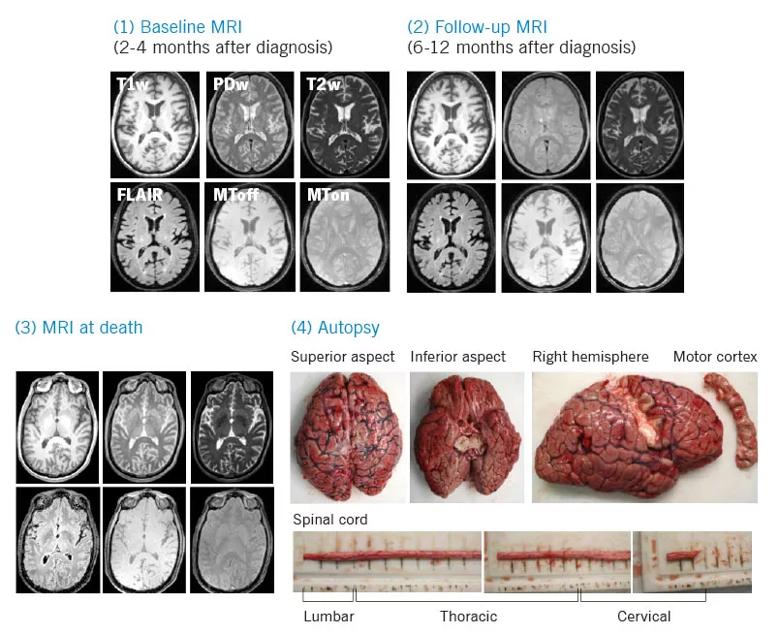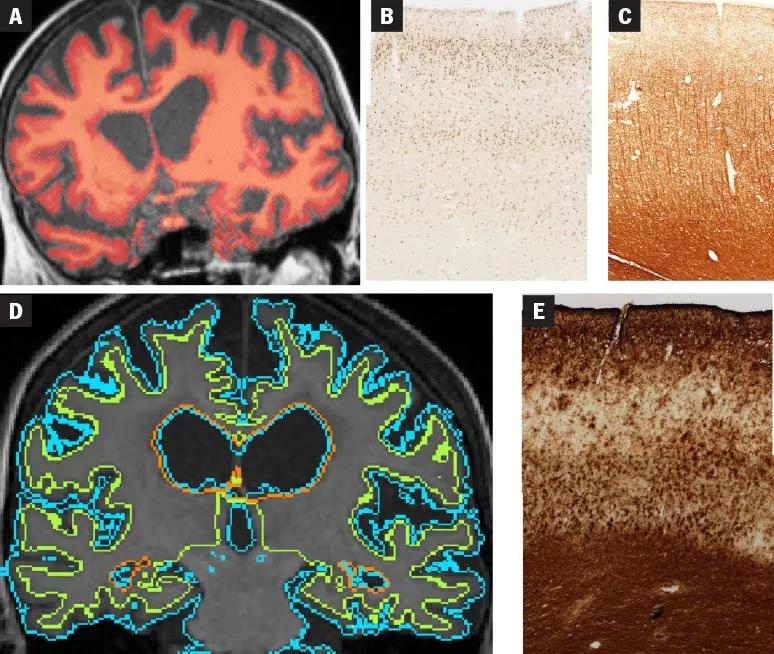Research seeks MRI biomarkers of in vivo pathogenesis

By Jacqueline Chen, PhD, and Erik P. Pioro, MD, PhD
Cleveland Clinic is a non-profit academic medical center. Advertising on our site helps support our mission. We do not endorse non-Cleveland Clinic products or services. Policy
More than 150 years after the initial description of amyotrophic lateral sclerosis (ALS) by Dr. Jean-Martin Charcot, its cause remains unknown and current treatments improve survival by only a few months. How will this disease be stopped?
An interdisciplinary team at Cleveland Clinic believes the answer lies in a better understanding of ALS pathogenesis through coordination of longitudinal brain MRI studies with histopathologic analyses following rapid autopsy. Our team has initiated an innovative research program to bring that coordination to bear across a growing series of ALS patients, with the goal of illuminating ALS pathogenesis and identifying new therapeutic targets.
These efforts are directed out of the Department of Neurosciences and the Section of ALS and Related Disorders in the Neurological Institute’s Neuromuscular Center, with collaboration from the departments of Anatomic Pathology, Diagnostic Radiology and Biomedical Engineering.
Degeneration of motor neurons in the brain, brainstem and spinal cord is the central feature of ALS. The inability to directly observe why and where the motor neurons degenerate has proved to be an important obstacle to the discovery of effective therapies.
In the absence of direct observation of motor neuron degeneration, a biomarker that is directly associated with the disease process would be invaluable. Biomarkers of disease progression in ALS clinical trials and drug development to date have included demographics, clinical presentation, functional testing and — increasingly — analysis of biofluids or other tissues. Although such metrics may be associated with disease progression, they do not elucidate the pathological processes that cause motor neuron degeneration.
MRI of the brain and spinal cord of patients with ALS can be performed in vivo to potentially reveal underlying pathology at one or more time points. MRI provides a noninvasive and high-resolution method of investigating various aspects of pathology (demyelination, degeneration, inflammation, etc.) during a single imaging session. Although MRI can identify ALS pathology, its sensitivity is not well characterized and we do not fully understand which aspects of such pathology it detects.
Cleveland Clinic’s interdisciplinary approach addresses this need for a better understanding of ALS pathogenesis and for identification of new therapeutic targets. The program is unique in the high-quality data acquired throughout the disease course and postmortem.
The model for acquiring imaging and pathology data is outlined in Figure 1. Newly diagnosed patients are recruited to undergo brain MRI soon after diagnosis and approximately one year later. Patients may also consent to postmortem MRI and rapid autopsy of their brain and spinal cord. These procedures are performed immediately after death so that the MRIs are of similar quality to those acquired in vivo and tissues are in optimal condition for highly sensitive and specific immunostaining to characterize the pathology.

Figure 1. Model and timeline for imaging and histopathologic data acquisition in patients with ALS. (1) Six different in vivo MRI modalities at baseline in an ALS patient. (2) One-year follow-up in vivo MRI in the same patient. (3) Postmortem in situ MRI in an ALS patient. (4) Example photographs documenting the autopsy of an ALS patient.
Within this research program, 12 patients are being monitored with brain MRI and 13 patients have undergone postmortem MRI and rapid autopsy (as of autumn 2015).
Presently, we are determining which MRI metrics calculated from postmortem MRIs correspond with the ALS pathology observed on immunostained tissues (Figure 2). Preliminary results suggest:

Figure 2. Postmortem MRI and associated histopathology findings in patients with ALS. (A) Segmentation of the brain from MRI for atrophy quantification. (B and C) Immunostaining for neurons (B) and myelin (C) in the primary motor cortex. (D) Segmentation of the cerebral cortex from MRI for cortical thickness quantification. (E) Immunostaining for astrocytes.
When data sets of in vivo MRIs, postmortem MRIs and histopathology are completed, our goal will be to identify in vivo MRI biomarkers of ALS pathogenesis. Histopathologic evaluation will be performed on the brain tissue to identify regions of ALS pathology. Both in vivo and postmortem MRIs will be aligned with the brain tissue so that tissue regions exhibiting pathology can be mapped onto the MRIs. This will effectively allow us to look back in time and identify the earliest MRI abnormalities that eventually evolve into the pathology observed postmortem.
We are also using histopathological techniques to characterize the ALS motor neuron microenvironment. Preliminary results show:
In the future, we aim to classify ALS patients into categories based on their pathology pattern and to determine the MRI features that correspond with each category.
Our ongoing efforts are predicated on the following principles and suppositions:
We look forward to sharing insights we gain in the months and years ahead.
Dr. Chen is a staff researcher in Cleveland Clinic’s Department of Neurosciences.
Dr. Pioro is the Barry Winovich Endowed Chair in ALS Research and Director of the Section of ALS and Related Disorders in Cleveland Clinic’s Neuromuscular Center.

Real-world claims data and tissue culture studies set the stage for randomized clinical testing

New grant-funded investigation illustrates impact and reach of Cleveland Clinic Brain Study

How the new longitudinal investigation could become the Framingham Heart Study of brain health

Pilot findings show good patient acceptance and safety, early hints of efficacy

Study finds high prevalence of symptoms, willingness to seek treatment

Panel outlines research priorities around a promising alternative to imaging markers

Suspected factors include antithrombotic intensity, time on device, presence of thrombocytopenia

Preclinical studies will assess whether method developed for stroke recovery curbs deficits after brain injury